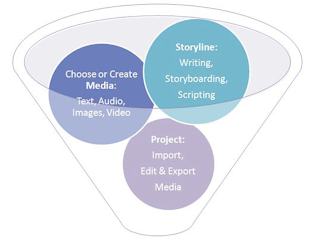DIGITAL STORYTELLING

I have posted before about the educational value of creating digital stories but I am going to add some new thoughts. We can all create a good story. No matter the age of the students you are teaching or what their interests or 'learning-language' may be, I can guarantee you that they have a story to tell. Let's help them as teachers to find their voice and to put their stories on the web where they can be shared with others in their class, school or even other schools around the world.
Some benefits which will come out of storytelling:
These aren't my own but I couldn't have said it better! (By : Med Kharbach)
- It develops creativity and critical thinking
- Students who are shy or afraid to talk in class get a chance to speak out their minds
- It empowers students voice to deliver rich, deep message that is capable of conveying a powerful message.
- It helps students explore the meaning of their own experience, give value to it, and communicate that experience with others.
- It promotes the notions of life long learning and independent learning
- It develops students communicative skills
- It is a reflective process that helps students reflect upon their learning and find deep connections with the subject matter of a course or with an out-of-class experience.
- It fosters students sense of individuality
- It also gives students an opportunity to experiment with self-representation and establish their identity
- Students creating digital stories develop proficiency with multimedia applications
What I can add is the additional and obvious language learning benefit. Getting students to write in a language which is not their native tongue is hard enough. Giving them the opportunity to write about something that interests them is a must and if you add the 'wow' factor of an engaging tool, you've won half the battle! Sharing their stories with their classmates is also a rich language learning strategy. They have to read and understand (hopefully!) others' stories which means that they are receiving more language input than if they had simply written down a story in paper-form and handed it in to the teacher.
The following link will take you the article written by Med Kharbach where you will find a long list of great 2.0 tools that can be used to write digital stories:
Get creating!